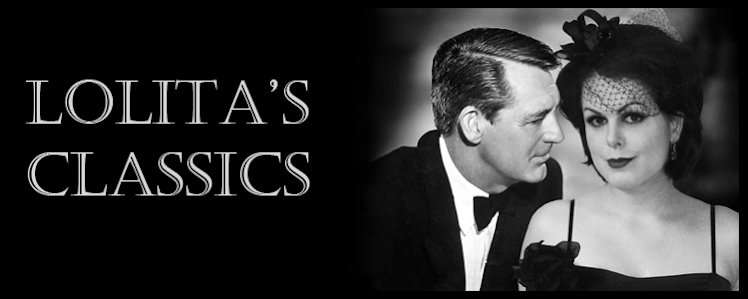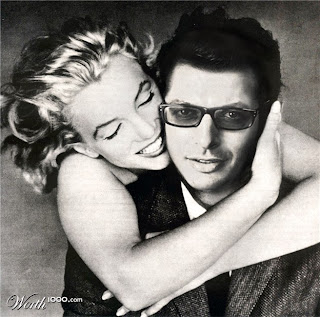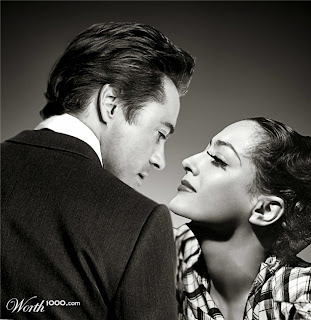It's fascinating that the most prudish era known to mankind produced the most longlived fictional monsters. Victorian Britain gave birth to Frankenstein's monster, Dracula and Dr. Jekyll and Mr. Hyde. Obviously the people needed some kind of outlet for their sin, and therefore were fascinated by gruesome monsters. (I know that if I had lived during the Victorian era, people would probably have picked up witch hunting again.)
Robert Louis Stevenson's
Strange Case of Dr Jekyll and Mr Hyde was published in 1885 and was adapted to the stage two years later. The central theme of the novel is the dual nature of every person, the good and the evil. This theme reflected contemporary times, since manners and moral were of vital importance. To be accepted, one simply had to push the bad and spontanious aside for a well-polished social shell. But what happens if one gives in to the passion and spontaneity? It becomes even harder to bury, of course.
Richard Mansfield as Dr. Jekyll and Mr. Hyde on stage.
Photo from 1895.
There are numerous film adoptions of the novel, but since I happen to own a two-disc DVD with the 1932 and the 1941 Hollywood versions I will naturally write about them. I aim to make a comparison - which is better? All right, obviously the pre-code one. The 1941 adoption (which is more a re-make of the 1932 version than a separate adaption of the original novel) was a box-office failure and Ingrid Bergman is generally considered miss-cast. Although I without a doubt prefer the 1931 version, I still think it is unfair to just dismiss it without a fair trial! Yes, it's a polished post-code version, Spencer Tracy is by far not as handsome as the young Fredric March... but I can still find one thing or two that I actually prefer in the 1941 version.
Be prepared for a screenshot filled post, as usual when I'm in that mood.
Cool Swedish poster, huh? Anyway, the story is probably familiar to you. Dr. Jekyll is a respected doctor who is fascinated with the possibility of separating the bad side and the good side of people. When his experiments succeed, he transforms into the purely evil Mr. Hyde. After a while he loses control over when and where he becomes Mr. Hyde, causing him to do quite horrible things. He is finally caught and killed. In the original novel he actually commits suicide, but obviously the film versions wanted the people to take revenge by killing him off themselves.
The 1932 version stars a handsome and dapper Fredric March. Being a quite early sound film one can detect a lot of the silent era in the filming. Cool transitions, expressionism-inspired mise-en-scène, round frame edges and men in lipstick. In all, the 1932 version is a lot more interesting editing wise compared to the more traditional 1941 version. It uses a lot of point-of-view shots, including the whole first scene, letting us see through Dr. Jekyll's eyes. It also has an occurring mirror theme, which is obviously the best and easiest metaphor for the dual nature of man.
Our first glimpse of Dr. Jekyll, through a mirror.
A fine example of the POV shots is a romantic moment with Dr. Jekyll's love interest, Muriel (who does not exist in the original novel, nor does "the other woman"). Moments like that makes the viewer care about the future of Dr. Jekyll and Muriel - something that the 1941 version missed totally. Lana Turner is just too damn pretty, cute, innocent and... "meh". Well, watch the build-up for the first kiss of the 1932 film:
Aren't you almost sharing that kiss yourself? Or am I just a little attracted to March myself, perhaps?
Soon after this rendez-vous Jekyll and his friend encounter a woman being attacked in the street. Being the kind doctor he is, he helps the woman to bed. Now, this part of the story (which, again, isn't in the original novel) is the enormous difference between the two film versions. On one hand we have Miriam Hopkins as Ivy, the slutty prostitute. On the other hand we have Ingrid Bergman, the flirtatious barmaid. (The dramatic transition from prostitute to barmaid in these films almost remind me of the pre- vs. post-code versions of
Waterloo Bridge...)
Let's take a close look at the infamous undressing scene in the 1932 version:
Dr. Jekyll carried Ivy home.
Dr. Jekyll: "You mustn't wear such tight a garter. It's bad for you."
... "It, eh... impedes the circulation."
Ivy giggles, and reaches for her skirt.
She pulls it up and reveals her legs... a lot of her legs.
She kicks off her shoes.
One garter comes off...
...is thrown...
... towards Dr. Jekyll.
A stocking and another garter comes off...
... and is again thrown to Dr. Jekyll.
He kicks one of the garters away with his cane, and follows it...
...straight to her bed.
Notice that all her clothes are lying on the floor - naughty girl!
Ivy throws herself at the handsome doctor.
They are interrupted by Dr. Jekyll's friend.
The viewer gets a glimpse of Miriam Hopkins' side boob.
"Come back. Soon..."
The scene fades out while Ivy swings her legs and chants "Come back..."
Yes, I did actually pause the film to show my boyfriend the side boob screenshot. In 12 days I will be the perfect wife.
Now, compare that scene to the 1941 version:
Dr. Jekyll and his friend drive Ivy home.
(He carries her the last bit, at least. She whines so much about it.)
Ivy is certainly wildly flirtatious, but only a hat and a coat comes off.
Glamorous laughter shot à la Hollywood studio era.
A remark about the tight garter, a proper distance away from the action.
Ivy removes her garter and shoves it up Dr. Jekyll's face. Kind of hot.
A kiss. Not a topless one.
They are interrupted.
Want to vote that these differences have some connection or other to the Hays Code? It's also interesting to compare the following scene between the films. In the 1932 version, Dr. Jekyll is intensely scolded by his friend for kissing another woman while being engaged to Muriel. In the 1941 version, the friend smiles at Dr. Jekyll and mentions something about him being better off with keeping his experiments to the laboratory.
'Nuff said about that, I believe. Except that I find it very unlikely that a woman should fall head-over-heels for Spencer Tracy's looks, while I can understand why Miriam Hopkins threw away all her clothes for young Mr. March... Yum.
Now, the transformation scene is awfully cool in the 1932 version. Obviously the make up was already on Fredric March's face the whole time, but shifting between different filters made it appear only gradually to the camera. Again, he does this in front of a mirror.
In the 1941 version they have a more convenient turn-away-the-camera-and-make-everything-fuzzy-during-transformation solution. Both versions also use the gradually-applying-make-up-while-turning-off-and-on-the-camera-thingy later on.
However, the hallucinations Dr. Jekyll has during transformation are more interesting and sadistic in the 1941 version. While in 1932 he only re-experienced earlier important moments and encounters (such as Ivy's swinging leg), the 1941 version is more innovative. We have Spencer Tracy excitingly whipping horses driving a carriage, the horses turn into Ivy and Beatrix, Beatrix gets trapped into a bottle while Ivy's head becomes the cork... Well, more like real hallucinations, I believe.
Now to another part I liked more about the 1940's version - the Mr. Hyde make up. Why did he look like a monkey in 1932? Supposedly they were going for a Neanderthal look, to underline Mr. Hyde's primitive nature, but... it doesn't work, does it? It took me several scenes with an abusive and intimidating Mr. Hyde before I could consider him frightening. Just compare them, and tell me who looks more like a madman and who looks more like a pet?


Some time into the film(s), Dr. Jekyll walks through a park on his way to his fiancée Muriel/Beatrix to announce their upcoming wedding over a dinner. That is the first time he spontaneously turns into Hyde. While that scene is less dramatic in the 1941 version, the 1932 version first lets Dr. Jekyll sit down on a park bench to joyfully observe a pretty little bird in a tree. While he says to the little bird that "you were not born to die" and smiles, a black cat suddenly attacks the bird and kills it. A nice little metaphor that the 1941 version (since it copies the 1932 one so much anyway) could have included.
Anyway, Mr. Hyde skips dinner and instead goes back to Ivy, who after an encounter with Dr. Jekyll has received the promise never to have to see Hyde again. She celebrates with champagne when suddenly her demon comes back to haunt her. Look at the similarities between the movies during this scene:
1932 version.
1941 version.
Even the layout of her apartment is almost identical! At least Bergman has a more decent décolletage.
There is also an earlier scene when Dr. Jekyll is smoking a pipe in front of a window in pouring rain... in both films.
1932.
1941.
I just don't understand why. Wouldn't it have been more interesting to make an entirely new adoption of the novel? Or at least, and entirely new adoption of the stage version of the novel, which is the case with the 1932 film. (It was also the stage version that added the love interest, if you wanted to know.)
Anyway, the film ends with the same frame too, Dr. Jekyll dead on the floor - shot to death by his best friend. While the 1932 version only has the poor old butler's words "Oh, Dr. Jekyll..." and a sound of a boiling pot to accompany that picture, the 1942 version has added a pompous church choir. One could see Hollywood declining as early as then...
1932.
1941. They at least flipped the picture.
Okay, I can't end the post with two dead men. Here's for you!


































+poster+1.jpg)
+5.jpg)


+2.jpg)
+4.jpg)
+6.jpg)


+Richard+Mansfield.jpg)
+poster+2+(SWE).jpg)
















































